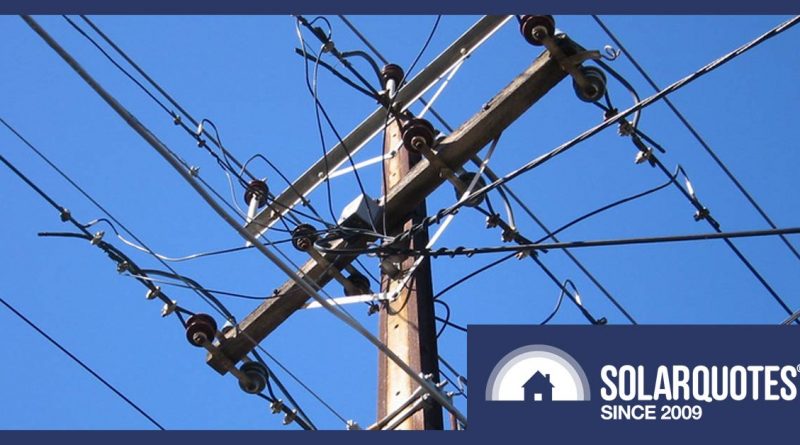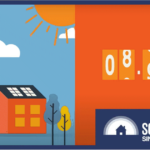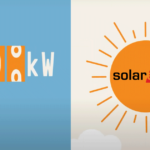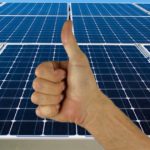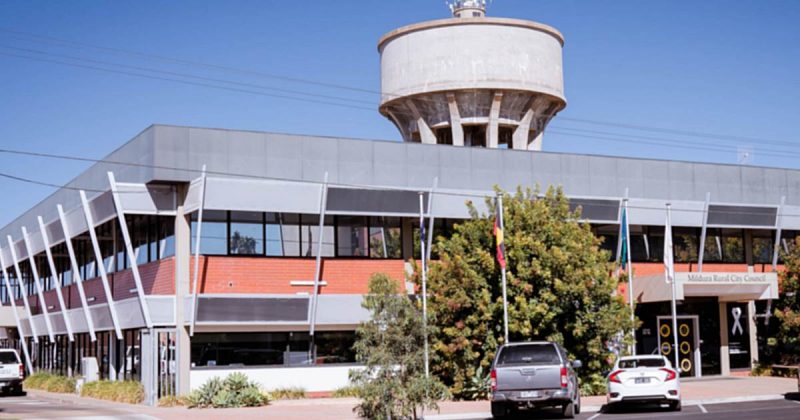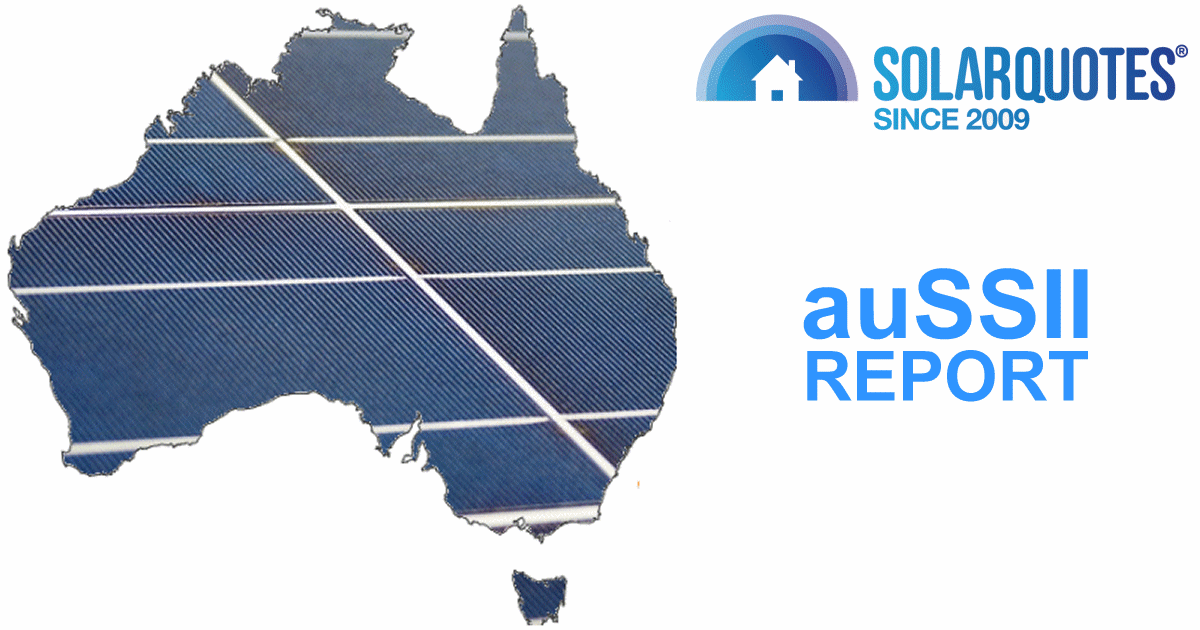Revealed: How SA’s Grid Will Accommodate The Relentless Uptake Of Rooftop Solar
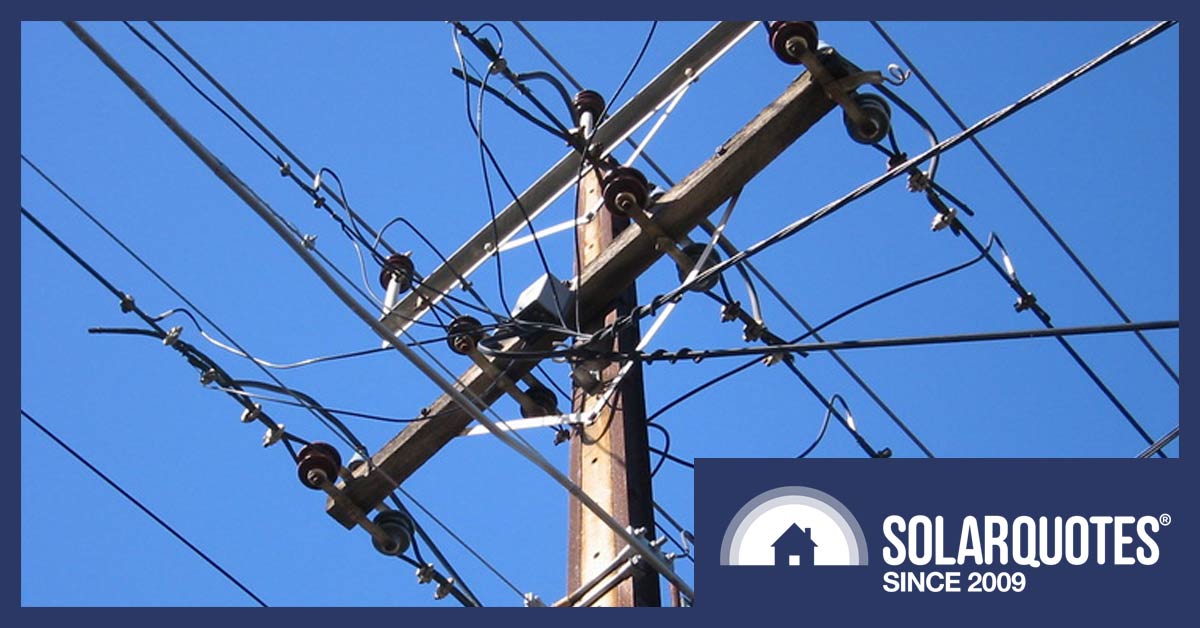
The famous, termite-proof South Australian Stobie Pole that holds SA’s distribution network off the ground.
The most interesting presentation at this year’s Smart Energy virtual conference was only 9 minutes long and by Future Networks engineer, Cathryn McDonald. In it, she described how South Australia Power Networks (SAPN) — the state’s Distributed Network Service Provider (DNSP), which is responsible for taking electricity from high voltage transmission lines and rooftop solar power systems and providing it to homes and businesses — intends to allow new rooftop solar to continue to export energy to the grid.
They are working on a range of different measures, but the two she focused on were:
- Optimizing voltages for network distribution — This is changing the voltage of power supplied by substations through the day to allow more solar power exports.
- Field trials of flexible exports using smart solar inverters — This involves testing solar inverters that respond to a signal from the internet and cut back on power exported to the grid when it’s necessary for grid stability.
These efforts to increase the total amount of solar exports the grid can handle are very important, as without them most new solar power systems would soon be prohibited from sending any electricity into the grid and required to have a zero export limit. This would reduce the economic value of rooftop solar panels to households and harm the planet by being a tragic waste of clean energy.
I’ll summarize the presentation below as well as give my own thoughts. If you see anything really stupid, that’s from me. Because the lights here stay on over 99% of the time I assume SAPN knows what they’re doing.
SA Has A Lot Of Rooftop Solar Power
We were told around one in three homes now have rooftop solar in South Australia. The graph below from the Australian PV Institute puts it at 37.9% but I suspect its figures are too high because it doesn’t account for scrapped systems:
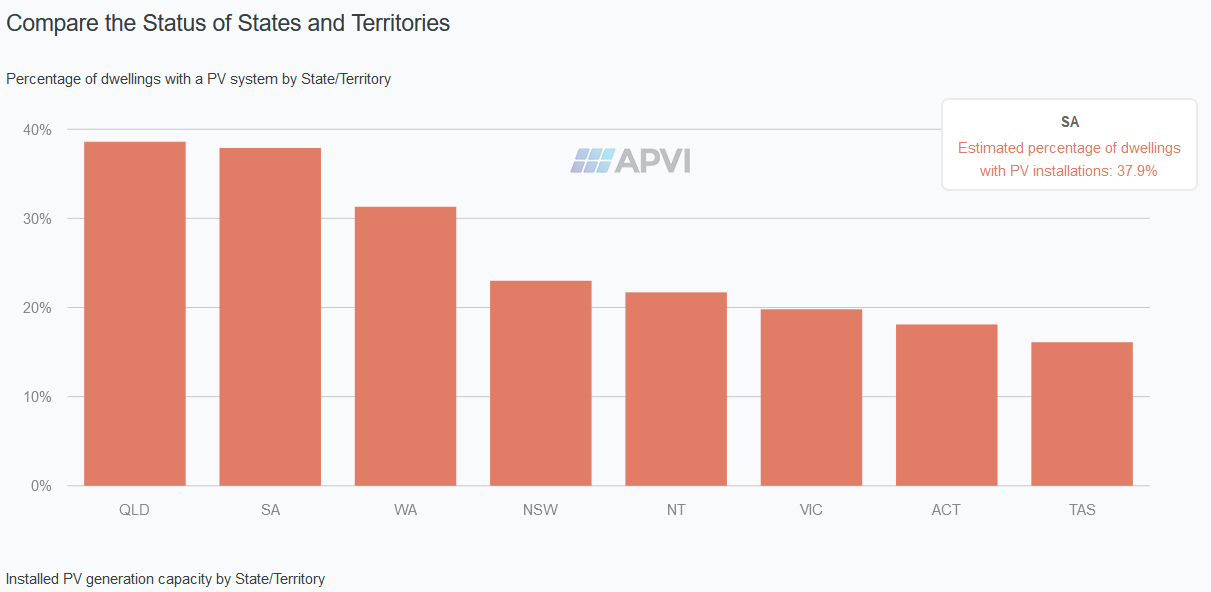
As you can see, Queensland is a little ahead, but they have some advantages when it comes to integrating distributed solar. Two major ones are:
- More industry giving Queensland higher and more flexible electricity consumption.
- Dynamic controlled loads that turn hot water systems on and off to assist with grid management.
Cathryn displayed the graphic below, showing the state of solar PV in SA at the moment:
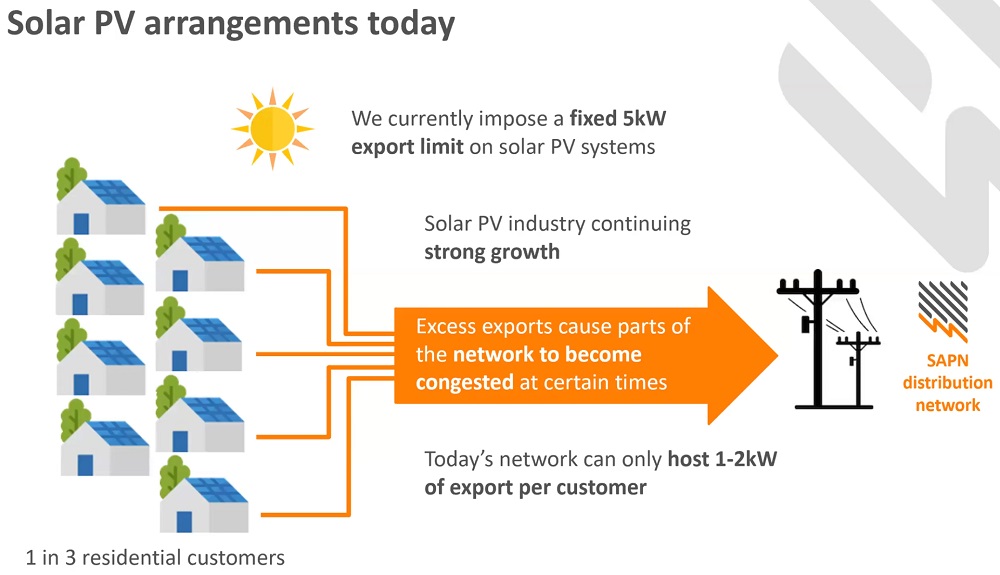 It says there is a fixed 5 kilowatt export limit on solar PV systems. This isn’t quite correct. Generally, households at the moment can export 5 kilowatts of solar power into the grid per phase. Most homes have single-phase power and can export 5 kilowatts, while 3 phase homes can export 15 kilowatts. But don’t be too surprised if this is changed to a fixed 5 kilowatt export limit per home, regardless of if its power is single or 3 phase, as SAPN may attempt to ration solar export capacity in this way.
It says there is a fixed 5 kilowatt export limit on solar PV systems. This isn’t quite correct. Generally, households at the moment can export 5 kilowatts of solar power into the grid per phase. Most homes have single-phase power and can export 5 kilowatts, while 3 phase homes can export 15 kilowatts. But don’t be too surprised if this is changed to a fixed 5 kilowatt export limit per home, regardless of if its power is single or 3 phase, as SAPN may attempt to ration solar export capacity in this way.
According to the graphic, if all properties had rooftop solar, the current grid could only handle 1-2 kilowatts of solar exports each without running into trouble at certain times. With one-third or possibly more homes already having solar panels — as well as a considerable amount of commercial solar — South Australia is already at around this limit according to SAPN.
After a quick internet search, I see the SA government says there are roughly 800,000 properties in the state. If each could only export 1.5 kilowatts, it suggests the maximum amount of solar energy exports the grid could handle would be around 1200 megawatts. The maximum amount of power the SA grid supplied last year was 3,140 megawatts during a heatwave.1
Multiple Methods Of Increasing Exports
While the presentation focused on the two main methods already mentioned, there is more than one way to skin an electron and SAPN is working on multiple approaches. The graphic below shows some of them:
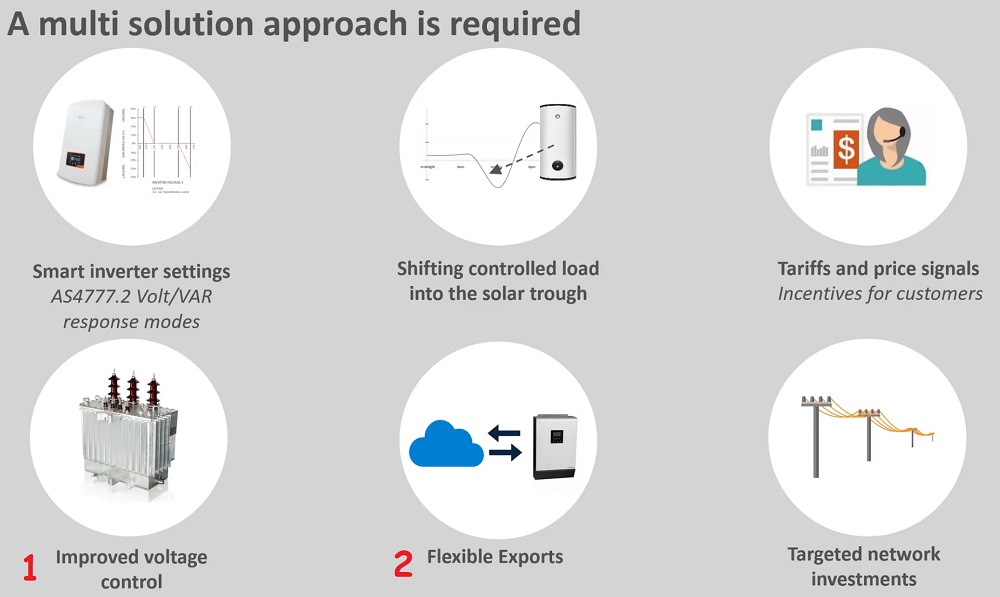
In case you were wondering, it wasn’t SAPN that threw in those big red numbers next to the two methods the presentation is focused on. That was me.
Improved Voltage Control Of Substations
Electricity grids are marvels of engineering. They are amazingly responsive because if I turn the kettle on, it will cause increased generation in a power station that could be thousands of kilometres away. But it achieves this impressive responsiveness in a very dumb way. Even the parts that specifically have the word “smart” at the front of their names can still be amazingly thick.
Electricity substations, those collections of humming transformers surrounded by wire fences that are scattered not-at-all artistically around the place, are an example of this.

Not these kinds of transformers.
These substations have been “set and forget” when it comes to voltage. SAPN sets them so the power received by homes and businesses should remain within the 216 to 253 volt range they are required to maintain.
This single setting results in problems because when solar power output is high and demand for grid electricity is low, the voltage will move close to or even exceed the maximum limit, as the graph below shows:
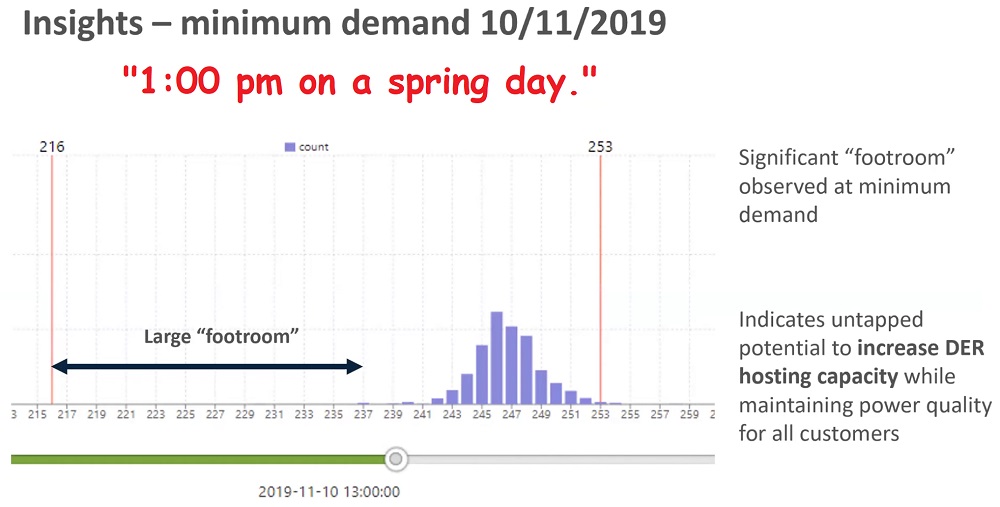
The graph shows at 1:00 pm voltages are towards the upper end of the permitted range, with a few households to the right of the far-right red line suffering from overvoltage that will cause solar inverters shut down and result in clean energy going to waste. It can also cause damage to electrical equipment.
If the substation voltage was set a little lower, then voltage for all properties would be within the correct range and the amount of rooftop solar that could be installed and operate without shutting down due to overvoltage would be increased. Or as the graph puts it, it would let them “…increase DER hosting capacity.” If you are wondering what DER is, it stands for Distributed Energy Resources. It’s almost always rooftop solar panels or solar and a battery, but it technically could be a micro wind turbine, micro hydroelectricity, or a macro hamster spinning a wheel connected to a generator.
The reason why substation voltage is set so it is high is to prevent voltage dropping below the permitted range when electricity demand is high but rooftop solar output is low. This is shown on the graph below, which we were told was “8:00 pm during a heatwave” on the 30th of January this year.
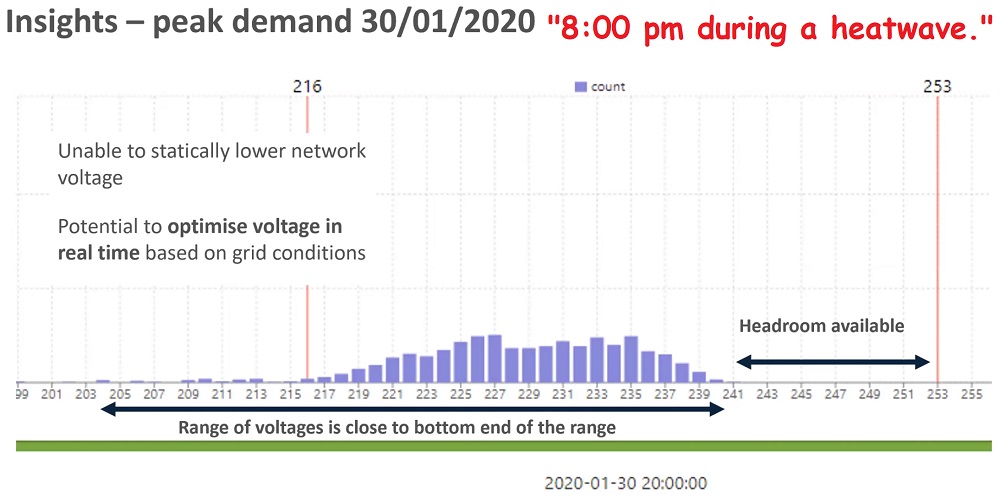
Because the sun set at 8:24 pm this day, solar power output would have been very low at this point. Demand for grid electricity was extremely high because it was a heatwave and air conditioners were working overtime. Because the grid was having difficulty meeting demand and was operating at close to its limit, it caused voltages to drop. The graph shows a number of homes to the left of the far-left red line suffering from undervoltage.
So the reason why substation voltages are set high enough to cause overvoltage problems is to help handle the load caused by air conditioners in the late afternoon and early evening on hot summer days. This makes air conditioning the main cause of high voltage in the middle of the day. If it hadn’t become so popular, substation voltage could and would be set at a lower level.
Rather than set and forget substation voltage, the simple solution is to adjust it through the day to match changing conditions and this is exactly what SAPN intends to do.
Flexible Exports With Smart Solar Inverters
SAPN says if every home had solar panels, the grid could only handle 1-2 kilowatts of exports from each at the moment. Most of the time the grid could handle more, but because the system is dumb, exports have to be set at a level appropriate for a worst-case situation and not at the average amount of solar exports the grid can handle.
A solution to this problem is to use smart solar inverters that can respond to a signal from the internet and adjust their exports to what the grid can handle at the time. This will — hopefully — allow them to export all the surplus solar power they produce most of the time, but cut back when it’s necessary for grid stability.
This is called Flexible Export Connection, and SAPN are already doing this with the Tesla Virtual Power Plant of around 1,000 Powerwall 2 batteries in South Australian homes. This graphic from the presentation lays it out using about as many arrows as there were at Agincourt:
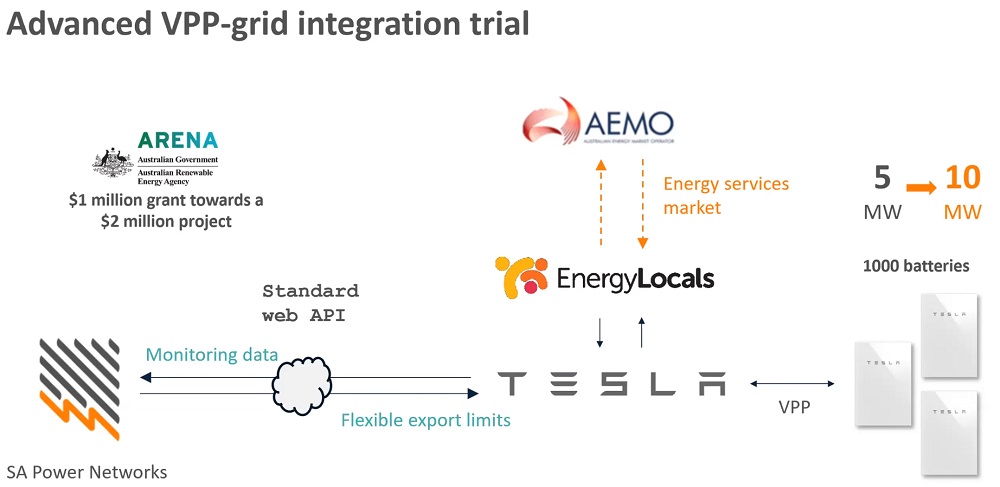
They are able to tell each household solar and battery system how much power they can export to the grid and for how long. At times, rather than exporting 5 kilowatts; which is the normal maximum now allowed by SAPN for a home with single-phase power, homes have been able to export 10 kilowatts. So while exports will be restricted at times, under the right circumstances it’s possible this could increase the total amount of solar energy exported by some homes.
Because most homes don’t have a solar battery and not all that do are part of a Virtual Power Plant, SAPN wants new solar inverters to be capable of behaving in a similar way. To test this they are going to run a trial with 300 households. This will start in the second half of 2021 and will run for one year. This graphic gives some details:
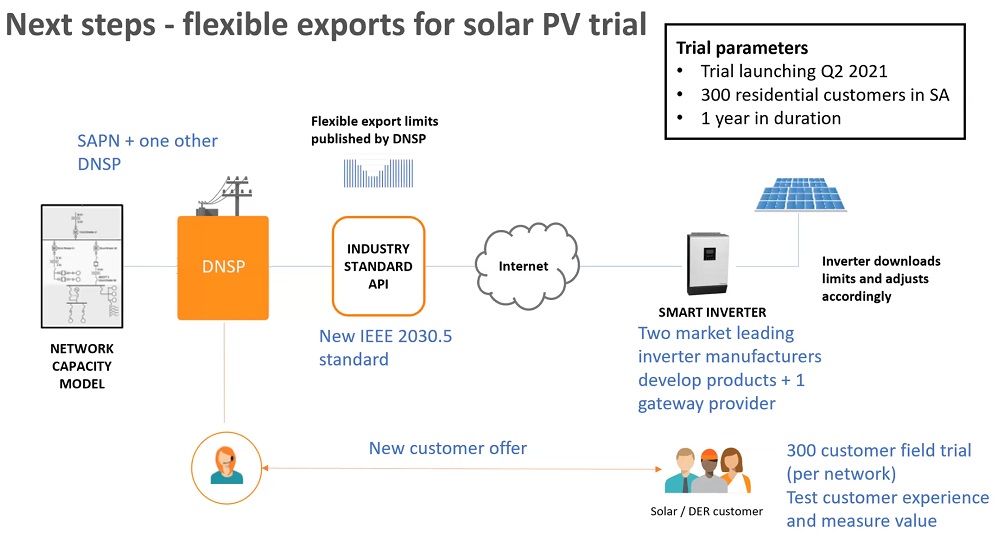
As the slide says another DNSP is involved and SAPN is the only one in SA, it’s possible there are households in another state taking part.
Assuming the trial doesn’t run into serious snags we can expect this to become a requirement for all new rooftop solar in the future.
Doubling Rooftop Solar
At the end of the presentation Cathryn said, with reference to flexible exports for solar PV:
“We’re hoping that this plus improved voltage control, plus all the other solutions on the slide a bit further before… We’re hoping that this can get us to a point where we can double the amount of solar we have on our network by 2025.”
While she didn’t say this specifically, I presume this means that if every residence in the state had solar panels they could export around 2-4 kilowatts each without the grid suffering congestion. As every residence isn’t going to get a solar power system, I hope this means new rooftop solar won’t be further restricted in how much power it can export to the grid except on uncommon occasions when it will need to be cut back to preserve grid stability.
Fingers crossed this is the case.
Footnotes
- This post was updated on 23 September 2020. It originally said there were only 82,000 properties in SA – which is an order of magnitude too low ↩
Original Source: https://www.solarquotes.com.au/blog/sapn-solar-exports/

